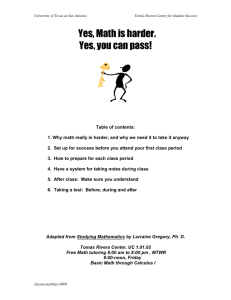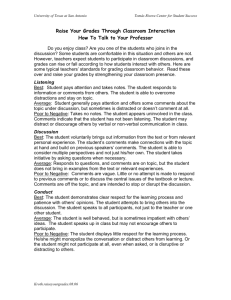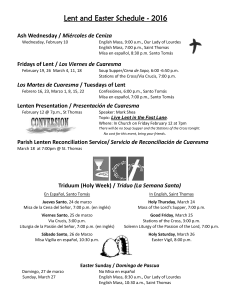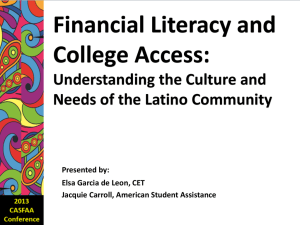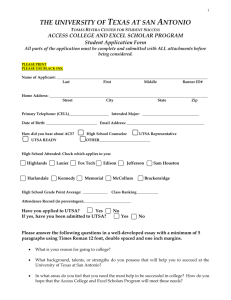Tomás and the Library - Chandler Unified School District
advertisement
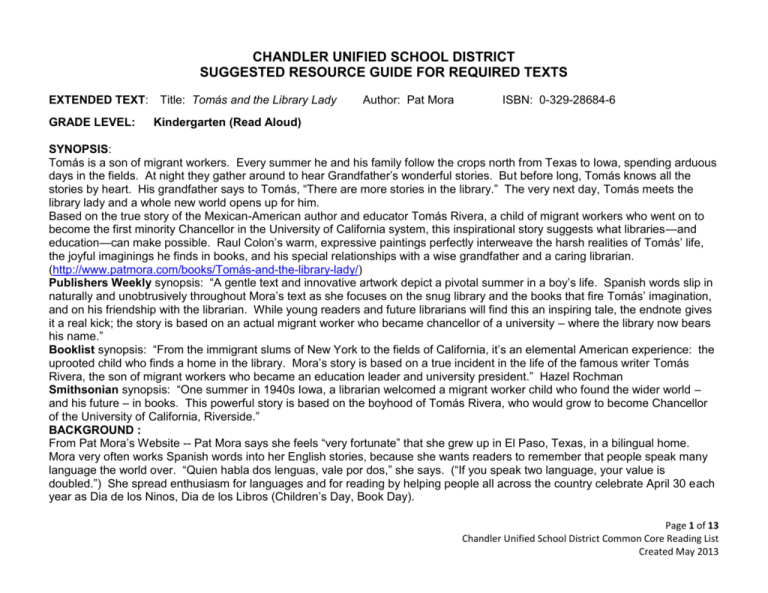
CHANDLER UNIFIED SCHOOL DISTRICT SUGGESTED RESOURCE GUIDE FOR REQUIRED TEXTS EXTENDED TEXT: Title: Tomás and the Library Lady GRADE LEVEL: Author: Pat Mora ISBN: 0-329-28684-6 Kindergarten (Read Aloud) SYNOPSIS: Tomás is a son of migrant workers. Every summer he and his family follow the crops north from Texas to Iowa, spending arduous days in the fields. At night they gather around to hear Grandfather’s wonderful stories. But before long, Tomás knows all the stories by heart. His grandfather says to Tomás, “There are more stories in the library.” The very next day, Tomás meets the library lady and a whole new world opens up for him. Based on the true story of the Mexican-American author and educator Tomás Rivera, a child of migrant workers who went on to become the first minority Chancellor in the University of California system, this inspirational story suggests what libraries—and education—can make possible. Raul Colon’s warm, expressive paintings perfectly interweave the harsh realities of Tomás’ life, the joyful imaginings he finds in books, and his special relationships with a wise grandfather and a caring librarian. (http://www.patmora.com/books/Tomás-and-the-library-lady/) Publishers Weekly synopsis: “A gentle text and innovative artwork depict a pivotal summer in a boy’s life. Spanish words slip in naturally and unobtrusively throughout Mora’s text as she focuses on the snug library and the books that fire Tomás’ imagination, and on his friendship with the librarian. While young readers and future librarians will find this an inspiring tale, the endnote gives it a real kick; the story is based on an actual migrant worker who became chancellor of a university – where the library now bears his name.” Booklist synopsis: “From the immigrant slums of New York to the fields of California, it’s an elemental American experience: the uprooted child who finds a home in the library. Mora’s story is based on a true incident in the life of the famous writer Tomás Rivera, the son of migrant workers who became an education leader and university president.” Hazel Rochman Smithsonian synopsis: “One summer in 1940s Iowa, a librarian welcomed a migrant worker child who found the wider world – and his future – in books. This powerful story is based on the boyhood of Tomás Rivera, who would grow to become Chancellor of the University of California, Riverside.” BACKGROUND : From Pat Mora’s Website -- Pat Mora says she feels “very fortunate” that she grew up in El Paso, Texas, in a bilingual home. Mora very often works Spanish words into her English stories, because she wants readers to remember that people speak many language the world over. “Quien habla dos lenguas, vale por dos,” she says. (“If you speak two language, your value is doubled.”) She spread enthusiasm for languages and for reading by helping people all across the country celebrate April 30 each year as Dia de los Ninos, Dia de los Libros (Children’s Day, Book Day). Page 1 of 13 Chandler Unified School District Common Core Reading List Created May 2013 Tomás and the Library Lady was Pat Mora’s first children’s book to be accepted for publication in 1989. However, it didn’t actually get published until 1997. Why did it take so long? The book’s illustrations slowed down the publication process. Raul Colon, the illustrator of the finished book, was actually the third illustrator to work on the book! Mora met the main character, Tomás Rivera, when she as an administrator at the University of Texas at El Paso. She described him as very intelligent, hard-working, and an avid reader. She said he had “a big smile and a wonderful sense of humor.” When he was the Chancellor of the University of California at Riverside (CA), she visited him. When asked in an interview how she and Tomás were alike, she responded, “We both loved to read and both liked doing well at school. We both went to college and became teachers. We both were parents and became university administrators. We both became writers and wanted our readers to know about the lives and dreams of Mexican Americans. We both felt lucky to be bilingual and wanted all people who are bilingual to be proud of their home languages.” (http://www.patmora.com/book_pages/Tomás.htm, http://www.eduplace.com/kids/hmr/mtai/mora.htm/?grade=4). In the same interview when asked her purpose in writing the story, Mora responded, “I was sad when Tomás died because I though he was such a special man and leader. I wanted to honor him, and I decided to write a children’s book about him so that children, teachers, librarians and parents would know the story of Dr. Tomás Rivera who was a writer and educator. I also wanted readers to think about the difficult life migrant workers have and how families and librarians help children succeed. I’m always surprised when even after having read Tomás and the Library Lady students can’t tell me what a migrant worker is.” Interdisciplinary connection: Social Studies LINKS http://www.patmora.com/books/Tomás-and-the-library-lady/: Video of Pat Mora talking about Tomás; interview with wonderful, extensive information about the book, its characters and her motivations for writing; suggested activities; links to other books written by Mora. Find Pat’s poem “Library Magic”. TEXT COMPLEXITY ANALYSIS: This book is listed on the Common Core State Standards Appendix B exemplar list for Read Aloud in the K-1 grade band. Quantitative: 440L (Scholastic Book Wizard) Grade Level Equivalent 3.5 (Scholastic Book Wizard). The 2-3 grade band begins at 420L. Qualitative: According to the Kansas Qualitative Measure of Rubric for Literacy Text, there is middle-high complexity in the meaning of this book. The issue of migrant workers and their families is presented through the eyes of a young boy, making this complex concept reachable for kindergarten through third grade students. However, scaffolding of this concept will most likely be necessary prior to its initial reading. The structure of the story is middle-low because its narrative structures of is more explicit than implicit, there are few shifts in point of view and there are no major shifts in time. The language of the story is middle-low, however, individual vocabulary (e.g., migrants) will need to be discussed and defined. The illustrations greatly aid the students understanding of the language in the text. Spanish words are scattered throughout, but through careful reading the students should not have difficulty accessing the meanings of these phrases. As for knowledge demands, for kindergarteners, this would be middle-high because most will not have the experience of migrant families’ lives. Page 2 of 13 Chandler Unified School District Common Core Reading List Created May 2013 Reader and Task: This book is a read aloud. In considering the reader and task as outlined on the Kansas list, the teacher will need to provide guidance, scaffolding and clarification to help the students attend to the text, critically analyze the relationships between various parts of the text and help students develop the attention, memory, and critical/analytical thinking skills. In addition, teachers will need to provide guidance to assist the students in “reading between the lines” to make connections/inferences among less explicit elements in the text, develop visualization skills (illustrations will help this) and questioning skills to assist in their comprehension of the text. As noted on various websites, the interest level of the text is considered high for students in kindergarten through 3rd grades. As previously stated, the teacher will need to provide and build on the students’ prior knowledge and experience. For many, this may be their first introduction to migrants and their families’ lives. There is not any content or theme that might make students, teacher, parents or administrators feel uncomfortable. MOTIFS AND THEMES: Moving, bilingualism, reading, friendship, grandparents, family roles, imagination/visualization Reading skills: prediction, inference, character traits, envisioning, monitoring for meaning/checking for comprehension, especially with ELL and SPED students LANGUAGE: Vocabulary Acquisition and Use Tier 2 Vocabulary Tier 3 Vocabulary midnight (p.1) Texas (p. 1) cot (p. 3) Iowa (p. 2) howled (p. 7) Papa Grande (p. 3) chattered (p.7) Spanish (p.7) thorny (p. 7) Various phrases in Spanish downtown (p. 8) Farm workers (2) eager (p.15) Snakebird (p. 12) town dump (p. 17) Iron (p. 17) Concept Words: migrant workers, seasonal jobs, bilingual, home languages, multicultural, relatives, ancestors Page 3 of 13 Chandler Unified School District Common Core Reading List Created May 2013 Conventions of Standard English or Knowledge of Language focus standard: Standard Code K.L.1d, f K.L.5b Description of where and how it fits with the extended text Standard Text Demonstrate command of conventions of standard English grammar and usage when writing or speaking. d. Understand and use question words (interrogatives) (e.g., who, what, where, when, why, how) f. Produce and expand complete sentences in shared language activities. With guidance and support from adults, explore word relationships and nuances in word meanings. b. Demonstrate understanding of frequently occurring verbs and adjectives by relating them to their opposites (antonyms). d. Encourage students to listen for questions and their answers in the text (e.g., page 7: “And who do you think was holding him?” page 10: “What’s your name?” & “What would you like to read about?” page 16: “Tomás, would you like to borrow two library books?” Ask text dependent questions (e.g., “What time of the year is it when the story begins?” (for ELL and SPED SLI provide closed set of winter, summer, spring or fall) How do you know? See below for more. f. Encourage students to retell parts of the story and retell their favorite stories (oral ones) to each other as Tomás does for his family. Verbs: followed, picked, bump-bumped, drink, carried, grabbed & others Adjectives: tired, old (car); cold (water); small (house); hot; windy (night); thorny (tree; and others. COMPANION TEXTS: 1-3 Short Informational Texts Text Title and Author A short description of the text and how it relates to the extended text Label Difficulty: Advanced Grade Level Meant for Scaffolding Page 4 of 13 Chandler Unified School District Common Core Reading List Created May 2013 Thank you, Mr. Falker by Patricia Polacco In this autobiographical story, Little Trisha, overjoyed at the thought of learning how to read, struggles when she finds that all the letters and numbers get jumbled up. Her classmates make matters worse by calling her dummy. Finally, in fifth grade, she is lucky enough to have a teacher who recognizes Trisha's incredible artistic ability, understands her problem, and takes the time to lead her to the magic of reading. Although dyslexia is never mentioned in the book, this story will provide great reassurance to children who struggle to overcome learning disabilities. G.E.: 4.8 1-3 Short Literary Texts Label Difficulty: Advanced Grade Level Meant for Scaffolding 1. G.E.: 3.1 Text Title and Author A short description of the text and how it relates to the extended text 1. More Than Anything Else by Marie Bradby 1. This is a fictionalized story about the life of young Booker T. Washington. Living in a West Virginia settlement after emancipation, nine-year-old Booker travels by lantern light to the salt works, where he labors from dawn till dusk. Although his stomach rumbles, his real hunger is his intense desire to learn to read. 2. G.E.: 4.3 2. Amber's mountain is beautiful, but it is a lonely place -- until the day Anna arrives, bringing both her friendship and the will to teach Amber how to read. Suddenly, Amber's world is filled with a new magic -- and new challenges. But when Anna returns to the city, will Amber be able to keep reading on her own? -- "Heartwarming". -- Publishers Weekly, starred review 2. Amber on the Mountain by Tony Johnston Page 5 of 13 Chandler Unified School District Common Core Reading List Created May 2013 STANDARDS-BASED ACTIVITIES: These activities will assist in the instruction of the extended text. ACTIVITY #1 READ ALOUD (a minimum of three days – Each new day have the students retell parts of the story to a partner and then using the illustrations have the students retell the story as a whole group.) RESOURCES: Map of the United States Transportation chart Sticky notes Markers/Dry erase STANDARDS ADDRESSED: With prompting and support, ask and answer questions about key details in a text. (K.RL.1) With prompting and support, identify characters, settings, and major events in a story. (K.RL.3) With prompting and support, describe the relationship between illustrations and the story in which they appear (e.g., what moment in a story an illustration depicts.) (K.RL.7) Ask and answer questions about unknown words in a text. (K.RL.4) With prompting and support, retell familiar stories, including key details. (K.RL.2) DESCRIPTION: 1. Using the map of the United States, ask the children if they know in which state we live. Mark this state (AZ) with a sticky note. 2. Ask, Who has traveled in a plane? (tally marks on a chart/use later for a math activity) Where did you go? Mark different destinations with sticky notes and names of cities. Why did you travel/go to name of city? (vacation, moved, visit Grandma, etc.) 3. Ask, Who has traveled by car? (tally marks) Repeat 2nd question in #2 and add more sticky notes to the map as required. 4. Ask, Who has traveled by train? (tally marks) Repeat 2nd question in #2 and add more sticky notes to the map as required. 5. Ask, Who has traveled by bus? (tally marks) Repeat 2nd question in #2 and add more sticky notes to the map as required. 6. Say, Today, we will read a story about a boy and his family who traveled every year. He traveled from Texas to Iowa. Listen to the name of the first state and tell me what sound you hear. Texas. /t/ You’re right. Texas starts with the sound /t/. Who knows the letter that makes the /t/ sound? T. You’re right. Can anyone find a state that starts with the letter T? Mark these. Read each one to students and ask them to tell you how many syllables they hear. Page 6 of 13 Chandler Unified School District Common Core Reading List Created May 2013 Place a sticky note with a “house” on it in Texas. Repeat same questions for identifying the state of Iowa. Mark Iowa with a blank sticky note (you will draw in a fruit/vegetable when students hear this information from the text) . Using a marker/dry erase draw a line from Texas to Iowa. Ask the students, How do you think the main character, Tomás, and his family traveled from Texas to Iowa? Car, plane, bus, or train? Text Teacher Says Page As you listen to the story, raise your hand when you know how 1 & 2 Tomás and his family traveled from his home in Texas to Iowa. How do you know how Tomás and his family traveled by car? What does the narrator mean when she describes the car as “tired” and “old?” Let’s listen again about how Tomás is feeling. Tell your partner how Tomás is feeling. Students’ responses By car The picture/illustration; because it says so One student shares with the class For his mom’s and dad’s job Page Now listen to understand why Tomás and his family were going to 3 Iowa. Introduce the vocabulary word “migrant worker.” Encourage students to make an inference about why Tomás wanted cold water, why he would drink it in large gulps, suck the ice and pour the last He’s really hot. drops on his face. Ask them to think of a time when they felt this way. In the summer when … Page Read page 4 and ask the students if they hear any words they do not Yes. 4 understand. Ask them if they know these words. Discuss different languages and whether any of the children or their parents/grandparents speak a different language. Repeat “Buenas noches” and tell them it means good night (or have them try to deduce this from the text). Ask the students to repeat this Buenas noches. too. Do the same with Papá Grande/Grandfather. Papá Grande Continue to read 1-2 pages and scaffold new information for students. Encourage inferencing and predicting. Page 7 of 13 Chandler Unified School District Common Core Reading List Created May 2013 ACTIVITY #2 RETELLING THE STORY WITH SEQUENCE STRIPS RESOURCES: Sentence Strips STANDARDS ADDRESSED: With prompting and support, ask and answer questions about key details in a text. (K.RL.1) With prompting and support, retell familiar stories, including key details. (K.RL.2) DESCRIPTION: 1. Say, Today we will retell what happened in the story Tomás and the Library Lady. Together we will write down all the events we can remember without using the book. First, turn to your partner and together tell as many parts of the story as you can. 2. Say, Now, let’s write down the parts together. We won’t worry if we write them down in the correct order. We’ll sequence them after we have all our ideas recorded. (Teacher will help students identify the beginning sounds and segment the words as the students share their ideas. These will be written on sentence strips. Teacher will prompt students to say when the first letter is capitalized (beginning word of sentence and for proper nouns) and prompt for ending punctuation. 3. Say, Now let’s look at all of our sentences. We’ll place these in order by putting them under these different categories. Let’s read these together. Add sequence words such as, in the beginning of the story, then, next, after that, at the end of the story. 4. Say, These words are called transition words. These words will help us sequence our sentences in the correct order. If we need more transition words, we will add them. Let’s read them one more time. 5. Say, Great! Now let’s read the sentences we wrote together and place these in the correct order. If we’re unsure of which happened first, we’ll look at the book after we’ve tried our best to remember the correct sequence. What happened first in the story? Students, with prompting and support, will read the sentences with their teacher. Ask individual students to place the sentence strips in the correct order. 6. Say, Now let’s use the book to check the sequence of our sentences. Use the text and pictures to do this. Ask the students to change/correct the sentence strips as appropriate. Have the students read with you. Page 8 of 13 Chandler Unified School District Common Core Reading List Created May 2013 ACTIVITY #3 CREATING CLASSROOM BOOKS RESOURCES: Sentence Strips from Activity 2 Handwriting/Drawing Paper STANDARDS ADDRESSED: With prompting and support, identify characters, settings, and major events in a story. (K.RL.3) With prompting and support, retell familiar stories, including key details. (K.RL.2) Use a combination of drawing, dictating, and writing to narrate a single event or several loosely linked events, tell about the events in the order in which they occurred, and provide a reaction to what happened. (K.W.3) DESCRIPTION: 1. Say, Let’s reread our summary of the story Tomás and the Library Lady. Read the sentence strips from Activity 2. 2. Say, Today, we will work together in groups of five. Plan to have a table group for each sentence strip. Arrange the groups with varying ability and language levels.) Each student in your group will create a page for your book. Let’s brainstorm ideas for what you could draw to illustrate each sentence. Students read each sentence together and brainstorm illustration ideas. The text may be used to facilitate this discussion. 3. Say, Each of you will copy one of the five sentences onto a page, and then you will illustrate your page. Remember to use your best handwriting. Children will write the sentence on the bottom of a page and then illustrate the top. 4. After students complete their group books, they will each practice reading their pages. Then each group will read their books to an adult (librarian, principal, secretary, cafeteria worker, etc.) on campus. WRITING PROMPTS: At this level writing is a combination of drawing, dictating, and writing. Opinion Prompts: o Review the illustrations of the times that Tomás was reading and used his imagination (dinosaurs, tiger, riding the horse). Which picture of Tomás using his imagination did you like the best? Tell why you liked it. o Review the ways that Papá Grande and the Library Lady helped Tomás. Which person helped Tomás the most, Papá Grande or the Library Lady? Tell why you think that person helped him the most. Page 9 of 13 Chandler Unified School District Common Core Reading List Created May 2013 Informational/Explanatory Prompts: o Write about your school library. Brainstorm ideas for what they can put in their writing. (e.g., describe what it looks like, tell who works there, tell about activities you do at the library.) o Use the information from the book to explain what a farm worker does. These workers are also called migrant workers. Narrative Prompts: o Write about a trip you have taken with your family. o Who is an important person in your life? What are the ways in which you show them that you care about them? What are three new things you could do to make them happy in the next week or two? Research Prompts: o Research working on a farm, things grown on a farm, or other aspects of farm life. o Research the life of Dr. Tomás Rivera, the person on whom this book is based. ADDITIONAL RESOURCES: These resources were enveloped by Martha Kateri Ferede, Ed.M., 2006, for the Family Involvement Storybook Corner on the Harvard Family Research Project website http://www.hfrp.org/var/hfrp/storage/fckeditor/File/teacher_guide2.pdf Video of Tomás and the Library Lady being read. Includes the pictures. http://www.watchknowlearn.org/Category.aspx?CategoryID=9470 The following resources are from the Basal Alignment Project from the HmH Reading Medallion 4th grade textbook. Text Dependent Questions What time of year is it when the story begins? How do you know? Describe how the author introduces the reader to Tomás. Who is telling the story? Answers It is summer. We know because the family is in the car traveling to Iowa and it is hot. The family works for farmers in Texas in the winter and for Iowa farmers in the summer “year after year”. The family is in the car in the middle of the night traveling from Texas to Iowa to farm for the summer “again”. Tomás misses his bed at home and tells his mother he is hot by saying, “if I had a glass of cold water…I would pour the last drops of water on my face.” He helps his grandfather out of the car, bids his family Page 10 of 13 Chandler Unified School District Common Core Reading List Created May 2013 Why are the words, “Buenas noches” in a different font? How do you know what these words mean? Thorny means having sharp points along the stem of a plant. Why did Papá Grande laugh when Tomás answered his question with, “A thorny tree” when he was telling his story? How does Tomás feel as he approaches the library? What words and phrases does the author use to show you? How does the illustration help the reader? In your own words, describe what happened during Tomás’ first visit to the library. What did it mean when the librarian said, “I will check them out in my name.”? Tomás left the library, “eager to show the new stories to his family.” How do you know what eager means? How is “eager” different than “excitement”? members “Buenas noches” and “curls up on the cot” to sleep. The story is told by a third person narrator. The evidence is the use of the pronouns he, they, and his. These words are spoken by Tomás in Spanish. The author follows these words with the English translation – “Good night”. Papá Grande laughed because Tomás knew the ending of the story. Tomás had said, “Tell us the story about the man in the forest.” He also knew the character in the story was held by a “thorny tree” and had scared himself. We can infer he has heard this story many times. Tomás is intimidated by the “big library” with its windows “like eyes glaring at him.” “He walked around and around…” “He slowly started climbing up, up the steps.” “His mouth felt full of cotton.” “He peeked in” to the “huge” library! The illustration shows just how small Tomás is as he “peeked in.”He jumped when the librarian tapped his shoulder. The librarian welcomed Tomás to “come inside” and gave him a drink of water. She asked his name and brought him books about “tigers and dinosaurs.” She gave him a chair, let him read, and sent him home with books. Students will know that to check out a book means to be able to take it with you – to borrow it. Because Tomás has never been to the library before, the reader has to infer that he cannot borrow books because he does not have a card or account. The librarian is being kind when she “checks the books out” and lets him take them. She trusts him. Eager means he is excited in a hurry and to show his family. He wants to do it and is looking forward to it. He “ran home” to show the books to his family and he reads them the story that day. Eager is different than excitement because at the root of his excitement, or stirred up feelings, is the yearning, this desire to read to the family from his new books. Page 11 of 13 Chandler Unified School District Common Core Reading List Created May 2013 What does, “He would put the books in the sun to bake away the smell mean”? Why use these words? What evidence in the story shows that Tomás is a good storyteller? What happens to Tomás when he reads to himself? How do the illustrations support this understanding? Compare how Tomás feels at the beginning and the end of the story. How does the author conclude the tale? Tomás found the books at the dump so they smell bad from the garbage. By “baking” them in the hot sun, the smell is diminished. “Baking” reinforces how hot the summer sun is in Iowa and helps us understand why Tomás is glad to be inside with cool water to drink when he is in the library. Tomás shows the pictures and reads to Papá Grande “first in Spanish and then in English.” He roars, “like a huge tiger” as he reads. The family laughed and “sat near him to hear his story.” On quiet days in the library, the librarian would say, “Come to my desk and read to me.” Now in the evenings, “he would read the stories to …” The illustrations show the big tiger in the room when Tomás is reading to the family. When Tomás reads, he looks at the pictures, reads and feels like he is in the stories. “He saw dinosaurs bending their long necks, he heard the cries of a wild snakebird, he felt the warm…he smelled the smoke…he rode a horse…” “He forgot about Iowa and Texas.” At the beginning of the story, Tomás is very hot and tired. He misses his bed. He tells his mom how thirsty he is with the story about the cold water. When the story concludes, Tomás is holding a “shiny new book.” He closes his eyes and “saw the dinosaurs.. heard the cry… felt the warm neck…” He is comforted by the story. Culminating Tasks Re-Read, Think, Discuss, Write 1. How does the author show that Tomás is a “storyteller” throughout the narrative? Use examples from the story to support your answer. When the story begins, Tomás uses the little story “if I had a glass of cold water… I would pour the drops of water on my face.” When he reads to the family, he shows the pictures and he makes them laugh. At the end of the story, Tomás is in the car, feeling like he is in the story with “the cry of the wild snakebird…” 2. The three central characters in the story all change this summer. Describe how Tomás, Papa Grande and the librarian are “changed” over the summer by interactions in the story. Tomás visited the library for the first time, then “whenever he could,” learned new stories from the books at the library, and assumed the role of “new storyteller” for the family. Papá Grande listened to Page 12 of 13 Chandler Unified School District Common Core Reading List Created May 2013 new stories in English and the library lady learned Spanish words and phrases, “Buenas tardes”, “pajaro”, and “libro.” She also learned about “pan dulce” or sweetbread that Tomás’ mother sends to thank her. Tomás and the library lady have both made a new friend. 3. Choose one or two words or phrases that describe both the library lady and Tomás. Using evidence from the text, justify your choice of words. Students may choose kind, eager to learn, polite, helpful, encouraging. Accept answers justified with examples from the story. 4. The author uses repetition in the story. For example, in the first paragraph, “the tired old car. Tomás was tired too. Hot and tired.” Find examples in the text where words are repeated and describe how that affects the meaning. The author repeats tired to emphasize how Tomás feels at the beginning of the story. The family “year after year bump-bumped along in their rusty old car” shows how tiring and uncomfortable this trip is for the family. When going to the library Tomás climbed slowly “up, up the steps.” This again, showed his feelings about going to the library for the first time. At the end of the story, the library lady says, “How nice. How very nice. Gracias, Tomás. Thank you.” This shows how she really feels grateful for the gift of the pan dulce. Additional Tasks Characters in the story are learning to use English as well as Spanish language. What are some of the words and phrases the author introduces in the story? How does she reveal the meaning of the words? Use the online dictionary at http://www.forvo.com or http://www.wordreference.com / to find the correct pronunciation of the words and phrases. Create a short dictionary of the words included in the text. Page 13 of 13 Chandler Unified School District Common Core Reading List Created May 2013
